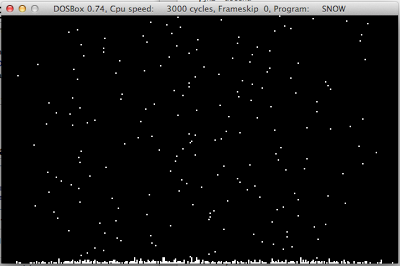Snow flakes keep falling on my... screen?
01 Dec 2012A very simple effect this time around. It’s snow flakes. The operating premise for the effect is very simple and goes like this:
- Generate 1 new snow flake at the top of the screen at every frame
- A snow flake has an absolute floor of the last line in video memory
- A snow flake should come to rest if it lands on top of another

That’s it! So, immediately we need a way to get random numbers. We’re using a 320x200 screen here and my dodgy routine for getting random numbers only returns us 8 bit numbers (which gets us to 255). We need to add some more width to these numbers if we expect to be able to randomize across the whole 320 column positions. Calling the random port twice and adjusting the resolution of the second number should do it for us, such that:
8 bits (256) and 6 bits (64) will give us 320 - or the ability to add using 14 bits worth of numbers, which in this configuration takes us up to 320. Perfect.
Here’s the code!
get_random:
; start out with ax and bx = 0
xor ax, ax
xor bx, bx
; get the first random number and
; store it off in bl
mov dx, 40h
in al, dx
mov bl, al
; get the second random number and
; store it off in al, but we only
; want 6 bits of this number
mov dx, 40h
in al, dx
and al, 63
; add the two numbers to produce a
; random digit in range
add ax, bx
retExcellent. We can span the breadth of our screen with random flakes. Now it’s time to progress them down the screen. Here’s the main frame routine to do so.
no_kbhit:
; put a new snowflake at the top
; of the screen
call get_random
mov di, ax
mov byte ptr es:[di], 15
decend:
; we can't move snowflakes any further
; than the bottom of the screen so we
; process all other lines
mov di, 63680
mov cx, 63680
next_pixel:
; test if there is a snowflake at the
; current location
mov al, es:[di]
cmp al, 0
je no_flake
; test if there is a snowflake beneath
; us at the moment
mov al, es:[di+320]
cmp al, 0
jne no_flake
; move the snowflake from where we are
; at the moment to one line below us
xor al, al
mov byte ptr es:[di], al
mov al, 15
mov byte ptr es:[di+320], 15
no_flake:
; move our way through video memory
dec di
dec cx
jnz next_pixel
; check for a keypress
mov ah, 01h
int 16h
jz no_kbhitThe code itself above is pretty well commented, you shouldn’t need me to add much more here. There are a couple too many labels in the code, but they should help to add readability. I’ll leave it as an exercise to the reader to implement different speeds, colours and maybe even some horizontal movement (wind). Cool stuff.